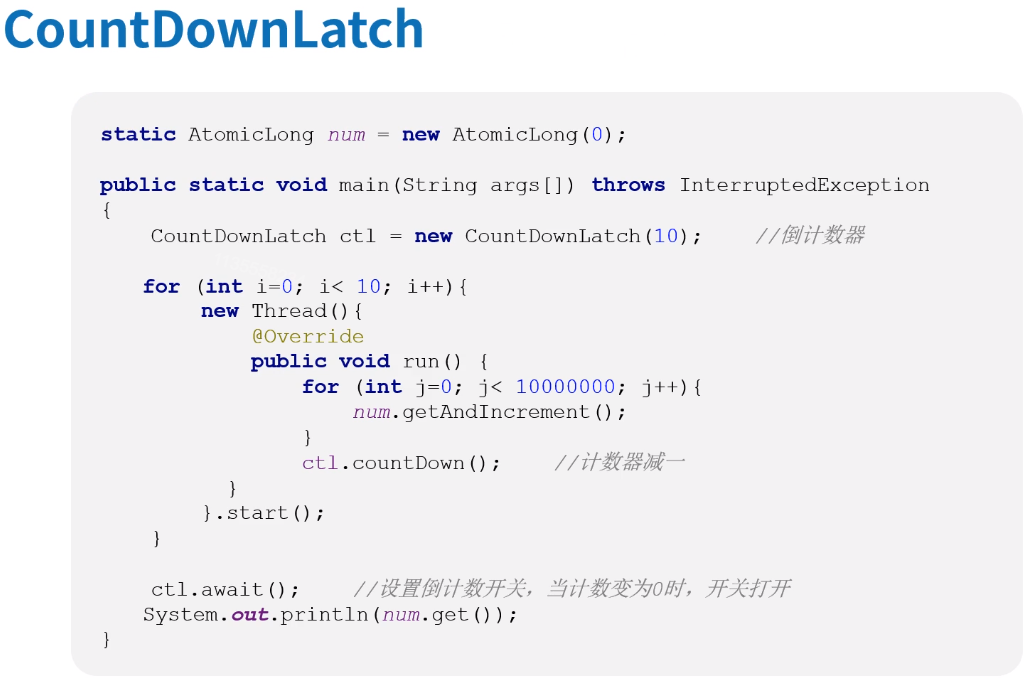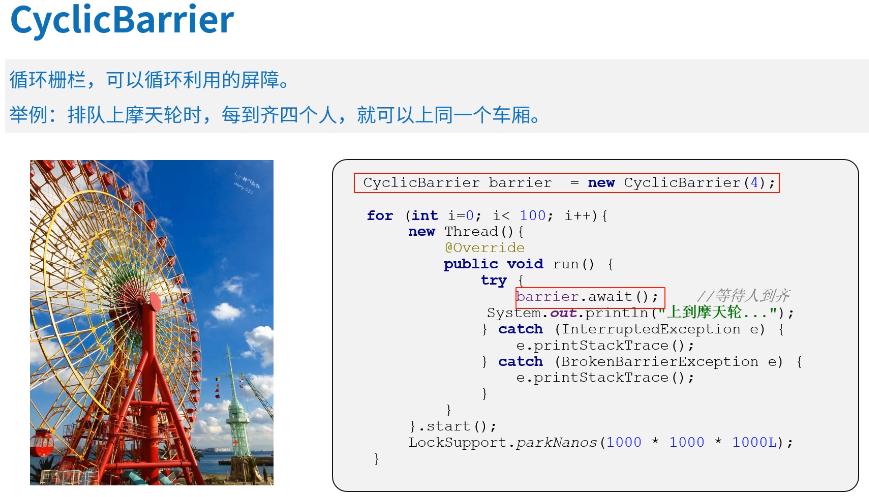
CountDownLatch的2个用途:
1. 所有线程都到达相同的起跑线后,再一起开始跑(并非同时开始,而是队列中一个唤醒另一个)【此情况需到达起跑线后再调用await()等待其他线程】
2. 所有线程都到达终点(执行完)后,再一起庆祝 (并非同时开始,而是队列中一个唤醒另一个)【此情况需到达起终点后再调用await()等待其他线程】
package com.study.concurrent_utils;
import java.util.concurrent.CountDownLatch;
public class Test_CountDownLatch {
/*
* 没隔1s开启一个线程,共开启6个线程
* 若希望6个线程 同时 执行某一操作
* 可以用CountDownLatch实现
*/
public static void test01() throws InterruptedException {
CountDownLatch ctl = new CountDownLatch(6);
for (int i = 0; i < 6; i++) {
new Thread() {
@Override
public void run() {
ctl.countDown();
try {
ctl.await();
// 6个线程都启动执行到此处时,打印如下
System.out.println("here I am...");
} catch (InterruptedException e) {
e.printStackTrace();
}
}
}.start();
Thread.sleep(1000L);
}
}
/*
* 开启6个线程,6个线程都执行完后,才执行某个操作
* 可以用CountDownLatch来实现
*/
public static void test02() throws InterruptedException {
JamesCountDownLatch ctl = new JamesCountDownLatch(6);
for (int i = 0; i < 6; i++) {
new Thread() {
@Override
public void run() {
System.out.println("after print...");
ctl.countDown();
}
}.start();
Thread.sleep(1000L);
}
ctl.await();
// 6条线程都执行完后同时打印这句话
System.out.println("main thread do something ...");
}
public static void main(String args[]) throws InterruptedException {
test02();
}
}
CountDownLatch实际应用
在zookeeper的master选举机制中,守护线程监听zk节点删除事件,一旦触发,CountDownLatch减1变成0,即触发线程继续递归调用选举逻辑

import java.util.concurrent.CountDownLatch; import org.I0Itec.zkclient.IZkDataListener; import org.I0Itec.zkclient.ZkClient; import org.I0Itec.zkclient.exception.ZkNodeExistsException; public class MasterElectionDemo { static class Server { private String cluster, name, address; private final String path, value; private String master; public Server(String cluster, String name, String address) { super(); this.cluster = cluster; this.name = name; this.address = address; path = "/" + this.cluster + "Master"; value = "name:" + name + " address:" + address; ZkClient client = new ZkClient("localhost:2181"); client.setZkSerializer(new MyZkSerializer()); new Thread(new Runnable() { @Override public void run() { electionMaster(client); } }).start(); } public void electionMaster(ZkClient client) { try { client.createEphemeral(path, value); master = client.readData(path); System.out.println(value + "创建节点成功,成为Master"); } catch (ZkNodeExistsException e) { master = client.readData(path); System.out.println("Master为:" + master); } // 为阻塞自己等待而用 CountDownLatch cdl = new CountDownLatch(1); // 注册watcher IZkDataListener listener = new IZkDataListener() { @Override public void handleDataDeleted(String dataPath) throws Exception { System.out.println("-----监听到节点被删除"); cdl.countDown(); } @Override public void handleDataChange(String dataPath, Object data) throws Exception { } }; client.subscribeDataChanges(path, listener); // 让自己阻塞 if (client.exists(path)) { try { cdl.await(); } catch (InterruptedException e1) { e1.printStackTrace(); } } // 醒来后,取消watcher client.unsubscribeDataChanges(path, listener); // 递归调自己(下一次选举) electionMaster(client); } } public static void main(String[] args) { // 测试时,依次开启多个Server实例java进程,然后停止获取的master的节点,看谁抢到Master // Server s = new Server("cluster1", "server1", "192.168.1.11:8991"); // Server s = new Server("cluster1", "server2", "192.168.1.11:8992"); Server s = new Server("cluster1", "server3", "192.168.1.11:8993"); // Server s = new Server("cluster1", "server4", "192.168.1.11:8994"); } }
手写CountDownLatch(基于AQS)
countDown()方法:释放共享锁,首先会尝试释放共享锁(其实际是做CAS操作将state减1,如果state减到了0,返回true),如果返回true,说明读锁已释放完,则将等待队列头部线程唤醒。
await()方法:获取共享锁,首先会尝试获取共享锁(其实际操作,获取并判断state值:return getState()==0 ? 1: -1;),若state不是0,即所有线程还没到齐,集体活动还不能开始,此时将其加入等待队列,并且开始自旋,不断判断自己是不是队列头部,即下一个开始跑的是不是自己,是的话就再次尝试获取共享锁,若失败就将自己挂起,若成功即从等待队列移除,并唤醒下一个要获取共享锁的线程。
package com.study.concurrent_utils;
import java.util.concurrent.locks.AbstractQueuedSynchronizer;
public class JamesCountDownLatch {
private Sync sync;
public JamesCountDownLatch(int count) {
sync = new Sync(count);
}
public void countDown() {
sync.releaseShared(1);
}
public void await() {
sync.acquireShared(1);
}
class Sync extends AbstractQueuedSynchronizer {
public Sync(int count) {
setState(count);
}
@Override
protected int tryAcquireShared(int arg) {
// 只有当state变为0时,加锁成功
return getState() == 0 ? 1 : -1;
}
/*
* countdown的方法
*/
@Override
protected boolean tryReleaseShared(int arg) {
for (;;) {
int c = getState();
if (c == 0)
return false;
int nextc = c - arg;
// 用CAS操作,讲count减一
if (compareAndSetState(c, nextc)) {
// 当state=0时,释放锁成功,返回true
return nextc == 0;
}
}
}
}
}

手写Semaphore(基于AQS)
package com.study.concurrent_utils;
import java.util.concurrent.locks.AbstractQueuedSynchronizer;
public class JamesSemaphore {
private Sync sync;
public JamesSemaphore(int state) {
sync = new Sync(state);
}
public void acquire() {
sync.acquireShared(1);
}
public void release() {
sync.releaseShared(1);
}
class Sync extends AbstractQueuedSynchronizer {
int state;
public Sync(int state) {
this.state = state;
}
@Override
protected int tryAcquireShared(int arg) {
for (;;) {
int available = getState();
int remaining = available - arg;
if (remaining < 0 || compareAndSetState(available, remaining))
return remaining;
}
}
@Override
protected boolean tryReleaseShared(int arg) {
for (;;) {
int current = getState();
int next = current + arg;
if (next < current) // overflow
throw new Error("Maximum permit count exceeded");
if (compareAndSetState(current, next))
return true;
}
}
}
}

package com.study.concurrent_utils;
import java.util.concurrent.CyclicBarrier;
public class TestCyclicBarrier {
public static void main(String[] args) throws InterruptedException {
CyclicBarrier cyclicBarrier = new CyclicBarrier(3, new Runnable() {
@Override
public void run() {
System.out.println(">>>>3个已满,走起<<<");
}
});
for (int i = 0; i < 30; i++) {
new Thread(new Runnable() {
@Override
public void run() {
try {
cyclicBarrier.await();
System.out.println(Thread.currentThread() + ":start...");
} catch (Exception e) {
e.printStackTrace();
}
}
}).start();
Thread.sleep(1000L);
}
}
}
>>>>3个已满,走起<<< Thread[Thread-2,5,main]:start... Thread[Thread-0,5,main]:start... Thread[Thread-1,5,main]:start... >>>>3个已满,走起<<< Thread[Thread-5,5,main]:start... Thread[Thread-3,5,main]:start... Thread[Thread-4,5,main]:start... >>>>3个已满,走起<<< Thread[Thread-8,5,main]:start... Thread[Thread-6,5,main]:start... Thread[Thread-7,5,main]:start...
手写CyclicBarrier(基于ReentrantLock)
ReentrantLock的Condition就是一个等待队列,ReentrantLock是一个可重入锁
package com.study.concurrent_utils;
import java.util.concurrent.locks.Condition;
import java.util.concurrent.locks.ReentrantLock;
public class JamesCyclicBarrier {
private final ReentrantLock lock = new ReentrantLock();
private final Condition condition = lock.newCondition();
// 记录当前这个批次有多少个
private int count = 0;
// 记录批次的大小
private final int parties;
// 分代
private Object generation = new Object();
public JamesCyclicBarrier(int parties) {
if (parties <= 0)
throw new IllegalArgumentException();
this.parties = parties;
}
// 进入下一个分代
public void nextGeneration() {
condition.signalAll();
count = 0;
generation = new Object();
}
public void await() {
// 实现排队,需要将线程放到等待队列
// 还需要将线程挂起
//
final ReentrantLock lock = this.lock;
lock.lock();
try {
// 记录当前的generation,相当于记录当前批次的id
final Object g = generation;
int index = ++count;
// 批次已经达到parties,
if (index == parties) {
// 进入下一个批次
nextGeneration();
return;
}
// 若未达到批次,就进入等待
for (;;) {
try {
condition.await();
} catch (InterruptedException e) {
}
if (g != generation) {
return;
}
}
} finally {
lock.unlock();
}
}
}
Future/Runnable
package com.study.futuretask;
import java.util.concurrent.Callable;
import java.util.concurrent.ExecutionException;
import java.util.concurrent.FutureTask;
import java.util.concurrent.locks.LockSupport;
public class Demo3_CallableTest {
public static void main(String args[]) throws InterruptedException, ExecutionException {
CallTask cTask = new CallTask();
JamesFutureTask<String> fTask = new JamesFutureTask<String>(cTask);
// 执行第一次
Thread th = new Thread(fTask);
th.start();
System.out.println("begain to get...");
String result = fTask.get();
System.out.println(result);
// 执行第二次,失败
Thread th1 = new Thread(fTask);
th1.start();
}
}
class CallTask implements Callable<String> {
@Override
public String call() throws Exception {
LockSupport.parkNanos(1000 * 1000 * 1000 * 5L);
System.out.println("done...");
return "James";
}
}
手写FutureTask
package com.study.futuretask;
import java.util.concurrent.Callable;
import java.util.concurrent.LinkedBlockingQueue;
import java.util.concurrent.atomic.AtomicReference;
import java.util.concurrent.locks.LockSupport;
public class JamesFutureTask<T> implements Runnable {
// future只能执行一次
private volatile int state = NEW;
private static final int NEW = 0;
private static final int RUNNING = 1;
private static final int FINISED = 2;
public JamesFutureTask(Callable<T> task) {
this.callable = task;
}
// 程序执行的结果
private T result;
// 要自行的task
Callable<T> callable;
// 获取结果的线层等待队列
LinkedBlockingQueue<Thread> waiters = new LinkedBlockingQueue<>(100);
// 执行当前FutureTask的线程,用CAS进行争抢
AtomicReference<Thread> runner = new AtomicReference<>();
@Override
public void run() {
// 判断当前对象的状态,如果是New就执行,如果
if (state != NEW || !runner.compareAndSet(null, Thread.currentThread()))
return;
state = RUNNING;
try {
result = callable.call();
} catch (Exception e) {
e.printStackTrace();
} finally {
state = FINISED;
}
// 方法执行完,唤醒所有线程
while (true) {
Thread waiter = waiters.poll();
if (waiter == null)
break;
LockSupport.unpark(waiter);
}
}
public T get() {
if (state != FINISED) {
waiters.offer(Thread.currentThread());
}
while (state != FINISED) {
LockSupport.park();
}
return result;
}
}
